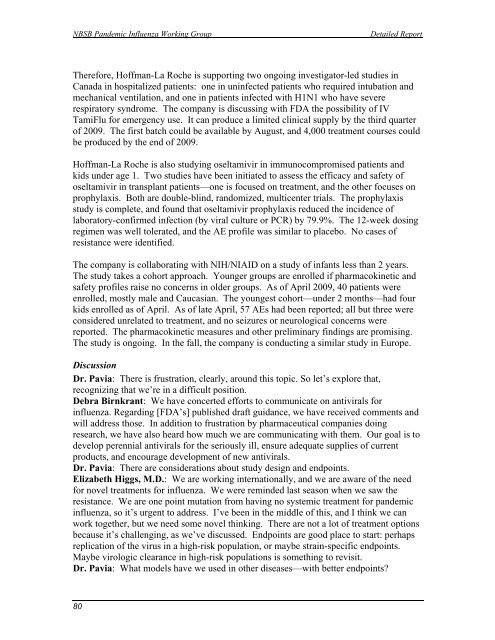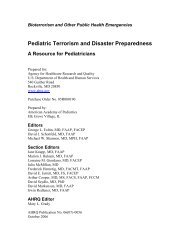H1N1 COUNTERMEASURES STRATEGY AND ... - PHE Home
H1N1 COUNTERMEASURES STRATEGY AND ... - PHE Home
H1N1 COUNTERMEASURES STRATEGY AND ... - PHE Home
Create successful ePaper yourself
Turn your PDF publications into a flip-book with our unique Google optimized e-Paper software.
NBSB Pandemic Influenza Working Group<br />
Detailed Report<br />
Therefore, Hoffman-La Roche is supporting two ongoing investigator-led studies in<br />
Canada in hospitalized patients: one in uninfected patients who required intubation and<br />
mechanical ventilation, and one in patients infected with <strong>H1N1</strong> who have severe<br />
respiratory syndrome. The company is discussing with FDA the possibility of IV<br />
TamiFlu for emergency use. It can produce a limited clinical supply by the third quarter<br />
of 2009. The first batch could be available by August, and 4,000 treatment courses could<br />
be produced by the end of 2009.<br />
Hoffman-La Roche is also studying oseltamivir in immunocompromised patients and<br />
kids under age 1. Two studies have been initiated to assess the efficacy and safety of<br />
oseltamivir in transplant patients—one is focused on treatment, and the other focuses on<br />
prophylaxis. Both are double-blind, randomized, multicenter trials. The prophylaxis<br />
study is complete, and found that oseltamivir prophylaxis reduced the incidence of<br />
laboratory-confirmed infection (by viral culture or PCR) by 79.9%. The 12-week dosing<br />
regimen was well tolerated, and the AE profile was similar to placebo. No cases of<br />
resistance were identified.<br />
The company is collaborating with NIH/NIAID on a study of infants less than 2 years.<br />
The study takes a cohort approach. Younger groups are enrolled if pharmacokinetic and<br />
safety profiles raise no concerns in older groups. As of April 2009, 40 patients were<br />
enrolled, mostly male and Caucasian. The youngest cohort—under 2 months—had four<br />
kids enrolled as of April. As of late April, 57 AEs had been reported; all but three were<br />
considered unrelated to treatment, and no seizures or neurological concerns were<br />
reported. The pharmacokinetic measures and other preliminary findings are promising.<br />
The study is ongoing. In the fall, the company is conducting a similar study in Europe.<br />
Discussion<br />
Dr. Pavia: There is frustration, clearly, around this topic. So let’s explore that,<br />
recognizing that we’re in a difficult position.<br />
Debra Birnkrant: We have concerted efforts to communicate on antivirals for<br />
influenza. Regarding [FDA’s] published draft guidance, we have received comments and<br />
will address those. In addition to frustration by pharmaceutical companies doing<br />
research, we have also heard how much we are communicating with them. Our goal is to<br />
develop perennial antivirals for the seriously ill, ensure adequate supplies of current<br />
products, and encourage development of new antivirals.<br />
Dr. Pavia: There are considerations about study design and endpoints.<br />
Elizabeth Higgs, M.D.: We are working internationally, and we are aware of the need<br />
for novel treatments for influenza. We were reminded last season when we saw the<br />
resistance. We are one point mutation from having no systemic treatment for pandemic<br />
influenza, so it’s urgent to address. I’ve been in the middle of this, and I think we can<br />
work together, but we need some novel thinking. There are not a lot of treatment options<br />
because it’s challenging, as we’ve discussed. Endpoints are good place to start: perhaps<br />
replication of the virus in a high-risk population, or maybe strain-specific endpoints.<br />
Maybe virologic clearance in high-risk populations is something to revisit.<br />
Dr. Pavia: What models have we used in other diseases—with better endpoints?<br />
80
















